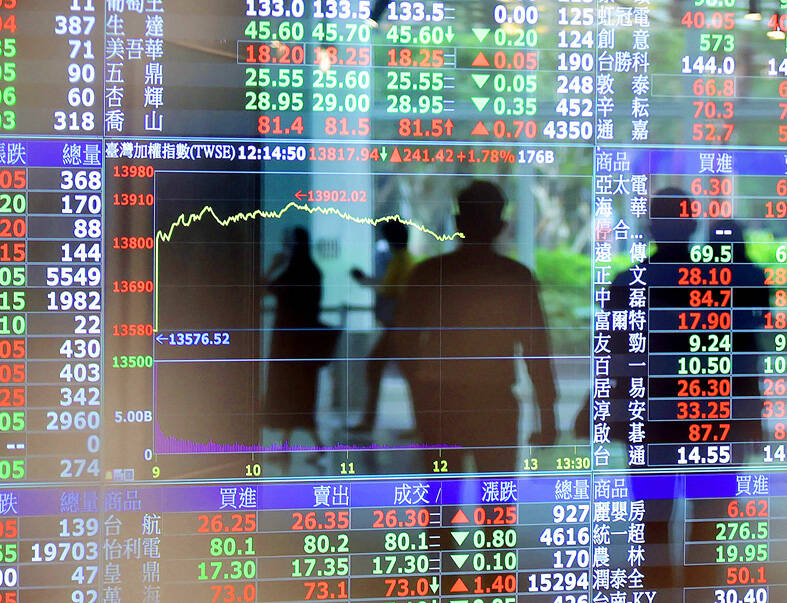The TAIEX yesterday rose sharply led by contract chipmaker Taiwan Semiconductor Manufacturing Co (TSMC, 台積電), which was up more than 4.5 percent amid liquidity-driven buying.
The market was also helped by a stronger New Taiwan dollar against the US dollar, which showed signs of less pressure on fund outflows.
The TAIEX ended up 291.05 points, or 2.18 percent, at 13,638.81, the highest since Oct. 7, when the index closed at 13,702.28.

Photo: CNA
Turnover on the main board totaled NT$237.795 billion (US$7.45 billion) yesterday, topping the average NT$200 billion in the previous five trading sessions and indicating that investors were more willing to buy.
Foreign institutional investors bought a net NT$24.13 billion of shares, Taiwan Stock Exchange data showed.
“It was a liquidity-driven uptrend today as funds returned to the local market because of the weaker US dollar,” Concord Capital Management Corp (康和投顧) analyst Lu Chin-wei (呂晉維) said.
“Investors at home and abroad appeared more willing to pick up bargains in the tech sector, which had been hit hard by rising interest rates,” Lu said.
TSMC rose 4.51 percent to close at the day’s high of NT$417. The stock’s gains contributed about 160 points to the TAIEX’s rise.
“After a recent slump, the stock’s valuation has become attractive to many bargain hunters,” Lu said.
Lu said the liquidity-driven buying is expected to continue pushing up the TAIEX, leading the market to challenge the high technical hurdles ahead of the 60-day moving average of 13,970 points in the short term.

The US dollar was trading at NT$29.7 at 10am today on the Taipei Foreign Exchange, as the New Taiwan dollar gained NT$1.364 from the previous close last week. The NT dollar continued to rise today, after surging 3.07 percent on Friday. After opening at NT$30.91, the NT dollar gained more than NT$1 in just 15 minutes, briefly passing the NT$30 mark. Before the US Department of the Treasury's semi-annual currency report came out, expectations that the NT dollar would keep rising were already building. The NT dollar on Friday closed at NT$31.064, up by NT$0.953 — a 3.07 percent single-day gain. Today,

‘SHORT TERM’: The local currency would likely remain strong in the near term, driven by anticipated US trade pressure, capital inflows and expectations of a US Fed rate cut The US dollar is expected to fall below NT$30 in the near term, as traders anticipate increased pressure from Washington for Taiwan to allow the New Taiwan dollar to appreciate, Cathay United Bank (國泰世華銀行) chief economist Lin Chi-chao (林啟超) said. Following a sharp drop in the greenback against the NT dollar on Friday, Lin told the Central News Agency that the local currency is likely to remain strong in the short term, driven in part by market psychology surrounding anticipated US policy pressure. On Friday, the US dollar fell NT$0.953, or 3.07 percent, closing at NT$31.064 — its lowest level since Jan.

Hong Kong authorities ramped up sales of the local dollar as the greenback’s slide threatened the foreign-exchange peg. The Hong Kong Monetary Authority (HKMA) sold a record HK$60.5 billion (US$7.8 billion) of the city’s currency, according to an alert sent on its Bloomberg page yesterday in Asia, after it tested the upper end of its trading band. That added to the HK$56.1 billion of sales versus the greenback since Friday. The rapid intervention signals efforts from the city’s authorities to limit the local currency’s moves within its HK$7.75 to HK$7.85 per US dollar trading band. Heavy sales of the local dollar by

The Financial Supervisory Commission (FSC) yesterday met with some of the nation’s largest insurance companies as a skyrocketing New Taiwan dollar piles pressure on their hundreds of billions of dollars in US bond investments. The commission has asked some life insurance firms, among the biggest Asian holders of US debt, to discuss how the rapidly strengthening NT dollar has impacted their operations, people familiar with the matter said. The meeting took place as the NT dollar jumped as much as 5 percent yesterday, its biggest intraday gain in more than three decades. The local currency surged as exporters rushed to